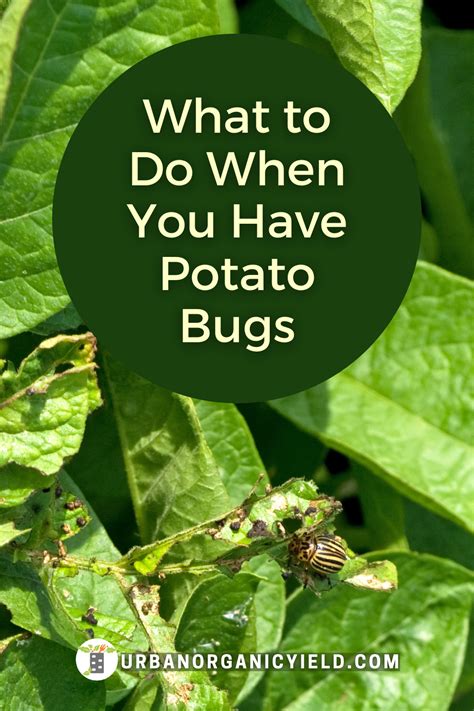Gardening Without Pests: Eliminate Potato Bugs for Good
Potato bugs, also known as Colorado potato beetles, are a gardener's worst nightmare. These voracious insects can decimate a potato crop in a matter of days, leaving you with nothing but ravaged plants and frustration. But fear not! This comprehensive guide will equip you with the knowledge and strategies to effectively eliminate potato bugs from your garden, ensuring a bountiful harvest. We'll cover everything from preventative measures to effective control methods, answering all your burning questions about these pesky pests.
What are Potato Bugs and Why are They Harmful?
Potato bugs (Leptinotarsa decemlineata) are bright yellow beetles with ten black stripes running along their wing covers. Both the adult beetles and their larvae feed on potato plants, devouring leaves, stems, and even the tubers themselves. Heavy infestations can completely defoliate potato plants, stunting their growth and significantly reducing yield. This damage not only impacts your harvest but can also weaken the plants, making them more susceptible to diseases.
How to Identify a Potato Bug Infestation?
Identifying a potato bug infestation early is crucial for effective control. Look for:
- Adult beetles: The characteristic yellow and black striped beetles are easily identifiable.
- Larvae: These are small, reddish-orange grubs with two rows of dark spots along their bodies.
- Leaf damage: Look for holes and skeletonized leaves, indicating feeding activity.
- Eggs: Small, yellowish-orange eggs laid in clusters on the undersides of leaves.
Preventing Potato Bug Infestations: A Proactive Approach
Preventing potato bug infestations is far easier than dealing with a full-blown invasion. Here are some effective preventative measures:
- Crop rotation: Avoid planting potatoes in the same location year after year. Rotate your crops to disrupt the beetle's life cycle.
- Clean up debris: Remove all potato plant debris from your garden at the end of the season. This eliminates overwintering sites for the beetles.
- Companion planting: Some plants, like marigolds and nasturtiums, are known to repel potato bugs. Planting them near your potatoes can help deter infestations.
- Floating row covers: These covers create a physical barrier, preventing beetles from accessing your potato plants. Remember to remove them for pollination if you're growing potato varieties that require it.
Effective Control Methods for Potato Bugs
If you find potato bugs in your garden, don't panic! Several effective control methods can help eliminate them:
- Handpicking: For small infestations, handpicking both adult beetles and larvae is an effective method. Dispose of them in soapy water.
- Neem oil: This natural insecticide disrupts the potato bug's life cycle, effectively controlling infestations. Apply according to the product instructions.
- Insecticidal soap: Another natural option, insecticidal soap works by disrupting the insect's cell membranes.
- Bacillus thuringiensis (Bt): This bacterium is a naturally occurring insecticide that is highly effective against potato beetle larvae. It's a safer option than broad-spectrum chemical insecticides.
What are the best organic ways to get rid of potato bugs?
Organic methods focus on natural solutions and minimizing environmental impact. Handpicking, neem oil, insecticidal soap, and Bacillus thuringiensis (Bt) are all effective organic options for controlling potato bugs. These methods are less harmful to beneficial insects and pollinators compared to chemical insecticides.
What natural predators eat potato bugs?
Several beneficial insects help control potato bug populations. These include:
- Ladybugs: These common garden helpers feed on various soft-bodied insects, including potato beetle eggs and larvae.
- Lacewings: Both the adult and larval stages of lacewings are predatory, consuming many small insects, including potato beetle eggs and larvae.
- Ground beetles: These beetles are nocturnal and often found in the soil, feeding on potato beetle larvae. Attracting these beneficial insects to your garden by providing habitat can be a helpful long-term solution.
How do I prevent potato bugs from coming back next year?
Preventing a return infestation involves a combination of strategies. Thorough fall cleanup to remove overwintering sites, crop rotation, and the use of preventative measures like companion planting or floating row covers all contribute to reducing the chances of another infestation the following year.
Conclusion: A Healthy Harvest Awaits!
Eliminating potato bugs from your garden doesn't require harsh chemicals. By combining preventative measures with effective control methods, you can protect your potato crop and enjoy a bountiful harvest. Remember, a proactive approach, diligent monitoring, and the judicious use of natural solutions will ensure a pest-free garden year after year.

